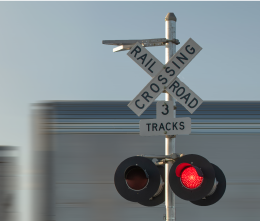
Mail on Rail
The thought of mail traveling by rail conjures up a picture of railway mail clerks sorting letters as a train rolls along into the night. Traditional railway mail service ended long ago, fading away as the use of passenger rail diminished and new methods of sorting mail by machine arose. The last run of a Railway Post Office was in 1977.
Today, the Postal Service mostly contracts with truck carriers for long-haul surface transportation, although it still uses rail occasionally. Intermodal service, which switches containers between various transportation methods such as trucks and trains, can be less expensive than truck transportation alone. Transportation involving rail, however, requires more active management to ensure that the mail arrives before scheduled train departure times.
Earlier this month, the Office of Inspector General issued an audit of a pilot program that placed mail on rail between several cities. The Postal Service started the pilot in June 2020 to save on surface transportation costs while still meeting service standards.
The audit found the contractors in the pilot didn’t consistently meet performance goals. Mail was frequently late, and management didn’t always monitor performance and report late trips. Management at one postal facility stopped using rail because it was regularly late but continued to pay for it, resulting in an annual cost of almost $460,000.
We made four recommendations to improve processes, training, and monitoring of intermodal service. Management agreed with three of the recommendations and partially agreed with the fourth.
What do you think about using rail to transport mail? What other types of transportation should the Postal Service use?

Leave a Comment
I do not buy the USPS's assertion that rail-based transportation can't provide adequate levels of service. The USPS's biggest private competitor, UPS, is one of the largest users of intermodal rail transport, and they have even tighter delivery timelines than the USPS offers. As well, FedEx Ground has been increasing its use of intermodal rail over the last few years, proving that intermodal rail can be fit into a parcel service's operations.
As well, to be frank, no one chooses the USPS because of speed--they choose the USPS because it's typically more economical than private parcel services. The USPS should embrace the space they fill and stop trying to compete on speed with private services and instead work to reduce costs and provide the most economical service possible, or at least give customers multiple options including a low-cost economical one. The current PMG's intent to relax service standards and move away from relying so heavily on air transport (via your contract with FedEx) and moving towards ground-based transportation has been a step in the right direction; moving that volume from HCR trucking to intermodal rail would be an even better step towards reducing costs for the USPS and for customers. Perhaps if the USPS did that, the USPS would be able to lower rates for the USPS's various Ground services, which right now are priced so closely to Priority Mail's prices that it almost never makes sense to ship Ground, as customers can get much faster service for only a few cents more, which of course causes an artificially high demand for air freight. If the USPS reduced costs of ground transport by moving more of that transport to intermodal rail, then lower Ground/Parcel Select pricing would likely drive even more volumes to those services, allowing even greater efficiencies of scale. Customers who do value faster services could then still choose to ship via Priority Mail at current rates, but the ability of customers to save even more money (as well as reduce carbon emissions) is something the USPS should embrace as soon as possible.
Late or canceled shipments are unfortunately a problem throughout the U.S. freight rail sector right now, but USPS likely has significant powers to compel the railroads to clean up their act. There is significant legal precedent federal intervention in the operation of the railroads to "protect the mails," e.g.the Pullman strike.
Getting mail by rail working will require a lot of up-front work by USPS's negotiators and legal team but IMO the goal is both attainable and worth striving for.